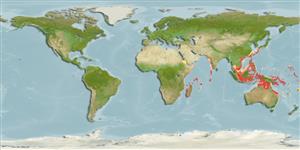>
Gobiiformes (Gobies) >
Gobiidae (Gobies) > Gobiinae
Etymology: Oplopomus: Greek, hoplon = weapon + Greek,poma, -atos = cover, operculum (Ref. 45335).
More on author: Bleeker.
Environment: milieu / climate zone / depth range / distribution range
Écologie
marin récifal; profondeur 1 - 66 m (Ref. 86942). Tropical
Indo-West Pacific: Maldives. Also reported from New Caledonia (Ref. 11889).
Taille / Poids / Âge
Maturity: Lm ? range ? - ? cm
Max length : 7.5 cm SL mâle / non sexé; (Ref. 48637)
Description synthétique
Clés d'identification | Morphologie | Morphométrie
Épines dorsales (Total) : 6 - 7; Rayons mous dorsaux (Total) : 10; Épines anales: 1; Rayons mous anaux: 10. Characterized by pale grey body color with numerous small white dots and larger brown spots on head and body; row of four large ovate blotches along side at level of pectoral fin base; base of caudal fin with additional spot; united pelvic fins, well developed frenum present; rounded caudal fin, slightly shorter than HL; longitudinal scale series 28-29; ctenoid scales on body and nape; cycloid scales on prepectoral area, breast, cheek and opercle; predorsal scales about 12; 1-2 small spines on preopercular margin just above angle; depth of body 4.2-4.7 in SL (Ref. 90102).
Inhabits coastal sand and mud flats, mainly in deepest parts of estuaries and at moderate depth, about 20 meters, in coastal bays (Ref. 48637).
Life cycle and mating behavior
Maturities | Reproduction | Spawnings | Egg(s) | Fecundities | Larves
Randall, J.E. and M. Goren, 1993. A review of the gobioid fishes of the Maldives. Ichthyol. Bull. J.L.B. Smith Inst. Ichthyol. (58):1-37, 5 pls. (Ref. 9360)
Statut dans la liste rouge de l'IUCN (Ref. 130435)
Menace pour l'homme
Harmless
Utilisations par l'homme
Outils
Articles particuliers
Télécharger en XML
Sources Internet
Estimates based on models
Preferred temperature (Ref.
123201): 25 - 29, mean 28 °C (based on 866 cells).
Phylogenetic diversity index (Ref.
82804): PD
50 = 0.7500 [Uniqueness, from 0.5 = low to 2.0 = high].
Bayesian length-weight: a=0.00708 (0.00333 - 0.01504), b=3.09 (2.92 - 3.26), in cm total length, based on LWR estimates for this (Sub)family-body shape (Ref.
93245).
Niveau trophique (Ref.
69278): 3.3 ±0.4 se; based on size and trophs of closest relatives
Résilience (Ref.
120179): Haut, temps minimum de doublement de population inférieur à 15 mois (Preliminary K or Fecundity.).
Fishing Vulnerability (Ref.
59153): Low vulnerability (10 of 100).
Nutrients (Ref.
124155): Calcium = 154 [68, 299] mg/100g; Iron = 0.817 [0.398, 1.595] mg/100g; Protein = 17.8 [15.8, 19.5] %; Omega3 = 0.106 [0.045, 0.206] g/100g; Selenium = 28.3 [12.6, 66.3] μg/100g; VitaminA = 141 [37, 513] μg/100g; Zinc = 2.19 [1.40, 3.30] mg/100g (wet weight);
